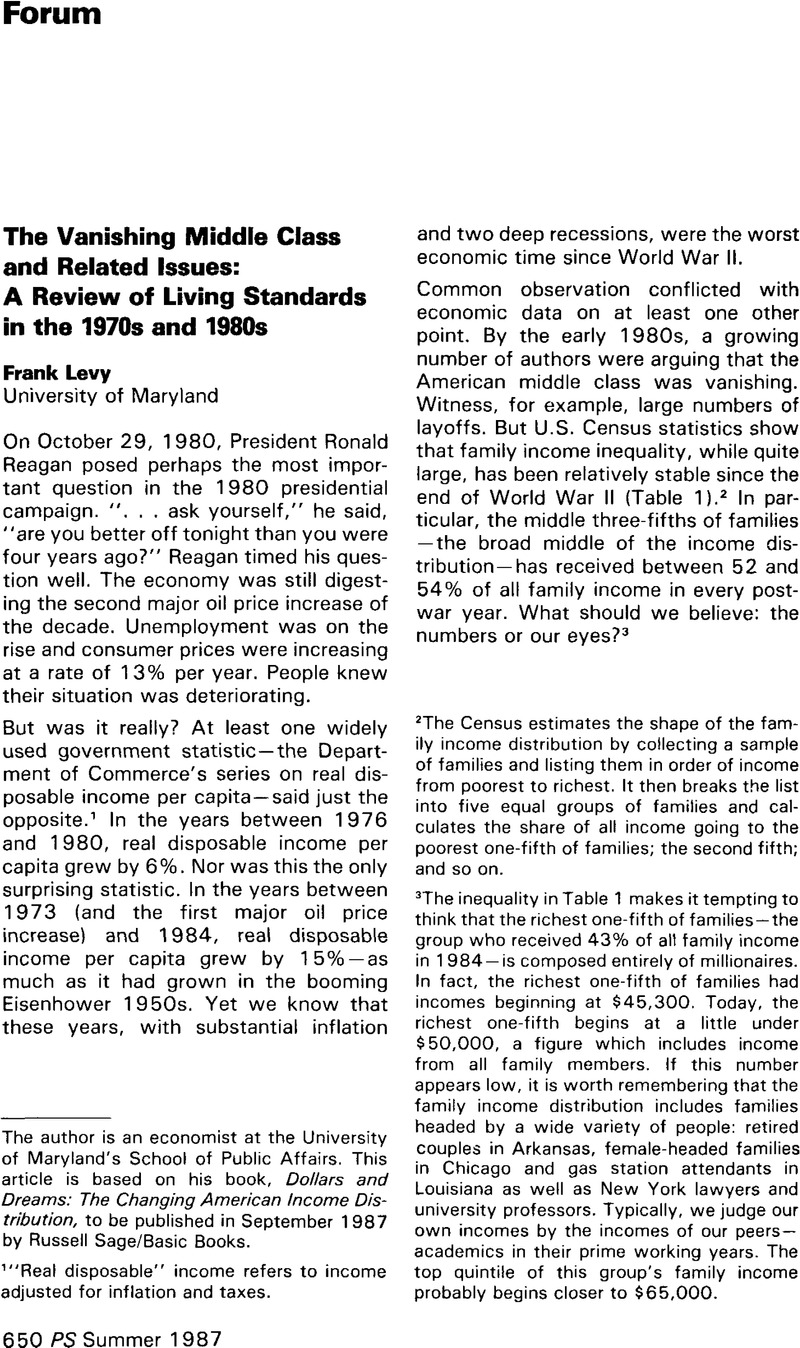No CrossRef data available.
Article contents
The Vanishing Middle Class and Related Issues: A Review of Living Standards in the 1970s and 1980s
Published online by Cambridge University Press: 21 November 2022
Abstract

- Type
- Other
- Information
- Copyright
- Copyright © The American Political Science Association 1987
References
The author is an economist at the University of Maryland's School of Public Affairs. This article is based on his book, Dollars and Dreams: The Changing American Income Distribution, to be published in September 1987 by Russell Sage/Basic Books.
1 “Real disposable” income refers to income adjusted for inflation and taxes.
2 The Census estimates the shape of the family income distribution by collecting a sample of families and listing them in order of income from poorest to richest. It then breaks the list into five equal groups of families and calculates the share of all income going to the poorest one-fifth of families; the second fifth; and so on.
3 The inequality in Table 1 makes it tempting to think that the richest one-fifth of families—the group who received 43% of all family income in 1984—is composed entirely of millionaires. In fact, the richest one-fifth of families had incomes beginning at $45,300. Today, the richest one-fifth begins at a little under $50,000, a figure which includes income from all family members. If this number appears low, it is worth remembering that the family income distribution includes families headed by a wide variety of people: retired couples in Arkansas, female-headed families in Chicago and gas station attendants in Louisiana as well as New York lawyers and university professors. Typically, we judge our own incomes by the incomes of our peersacademics in their prime working years. The top quintile of this group's family income probably begins closer to $65,000.
4 The father, making the transition from 40 to 50, would have been earning more too.
5 See, for example, Fuchs, Victor R., The Service Economy (New York: National Bureau of Economic Research and Columbia University Press, 1968).Google Scholar
6 There were other virtues as well, most notably the impact of wage growth in the steady reduction of poverty.
7 These are “high-end” estimates of the post-1973 wage declines. Lower estimates could be obtained by adjusting for inflation by the GNP consumption deflator rather than the Consumer Price Index (which some analysts believe overstated 1970s inflation). Similarly, income adjustments could attempt to correct for the growing cost of employer-provided fringe benefits in the 1970s. But corrections for these problems would still cause a man passing from age 40 to age 50 to experience about a 5% income loss rather than a 25–30% income gain.
8 See, for example, Bluestone, Barry and Harrison, Bennett, “The Great American Job Machine: The Proliferation of Low Wage Employment in the U.S. Economy,” study prepared for The Joint Economic Committee, December 1986.Google Scholar
9 There is still much about the productivity slowdown that we do not understand. For a general discussion, see Levy, Frank, Dollars and Dreams: The Changing American Income Distribution (Russell Sage Foundation/Basic Books, 1987)Google Scholar, Chapters 4 and 5.
10 A second element in fears of a vanishing middle class has been a demographic shift at the lower end of the income distribution in which elderly families have risen from the bottom of the distribution to the lower middle. Their places at the bottom have been taken by the growing number of families headed by single women and by two-parent families hurt by the 1980–82 recession. See Frank Levy, op. cit., Chapters 8 and 9.
11 A second device used to boost consumption was our willingness, both as individuals and as a nation, to take on high levels of debt. See Frank Levy, op. cit., Chapter 4.




